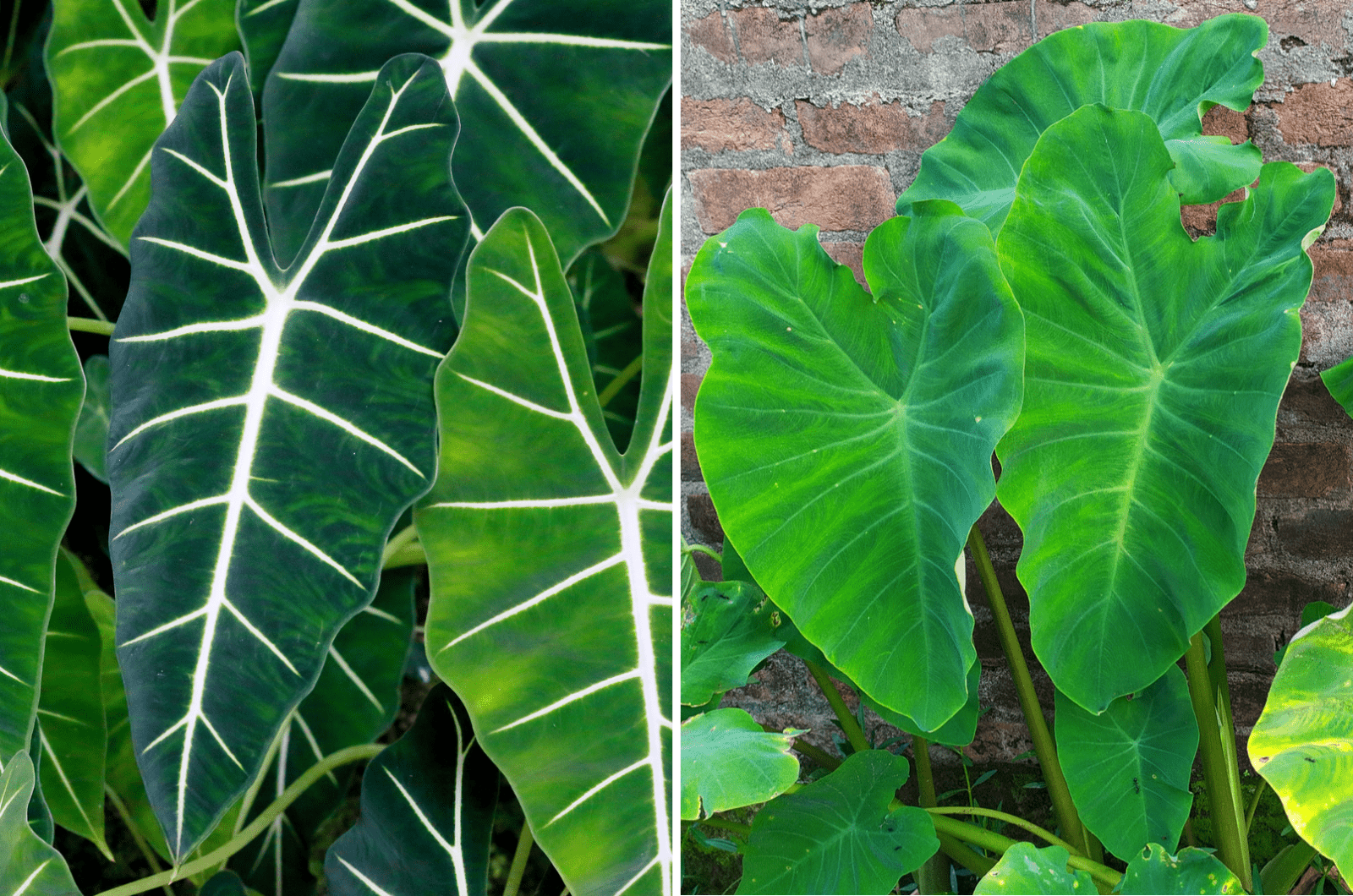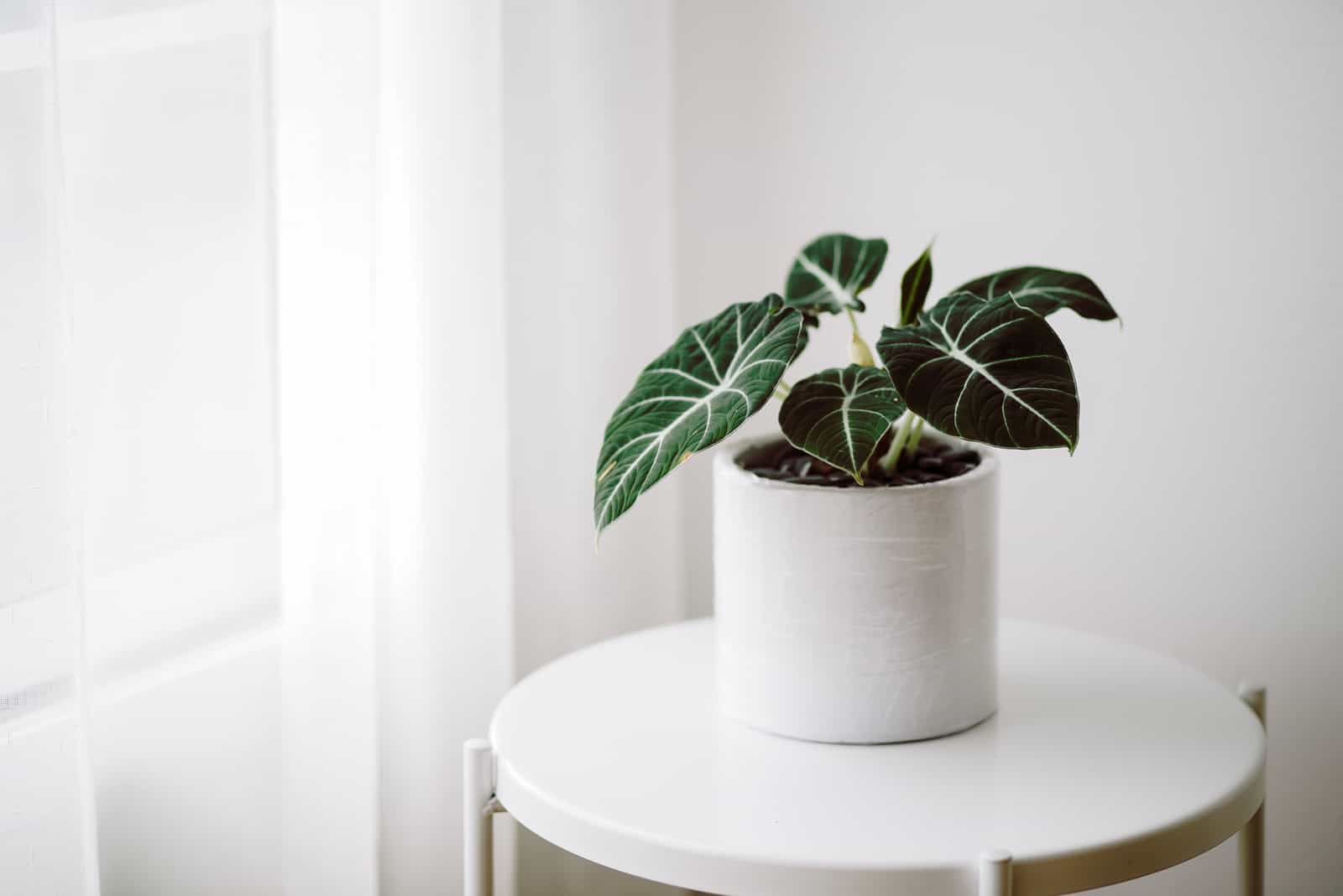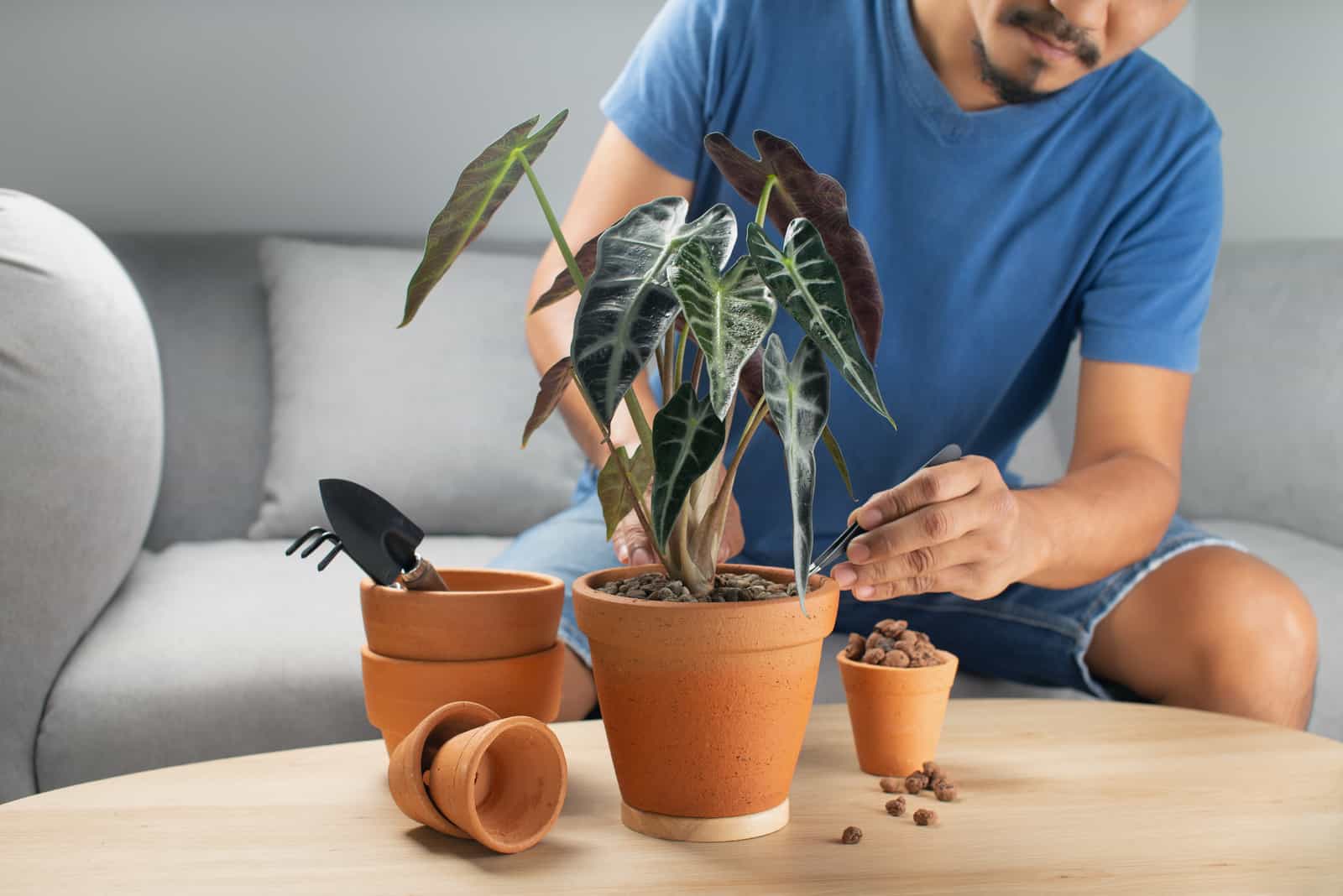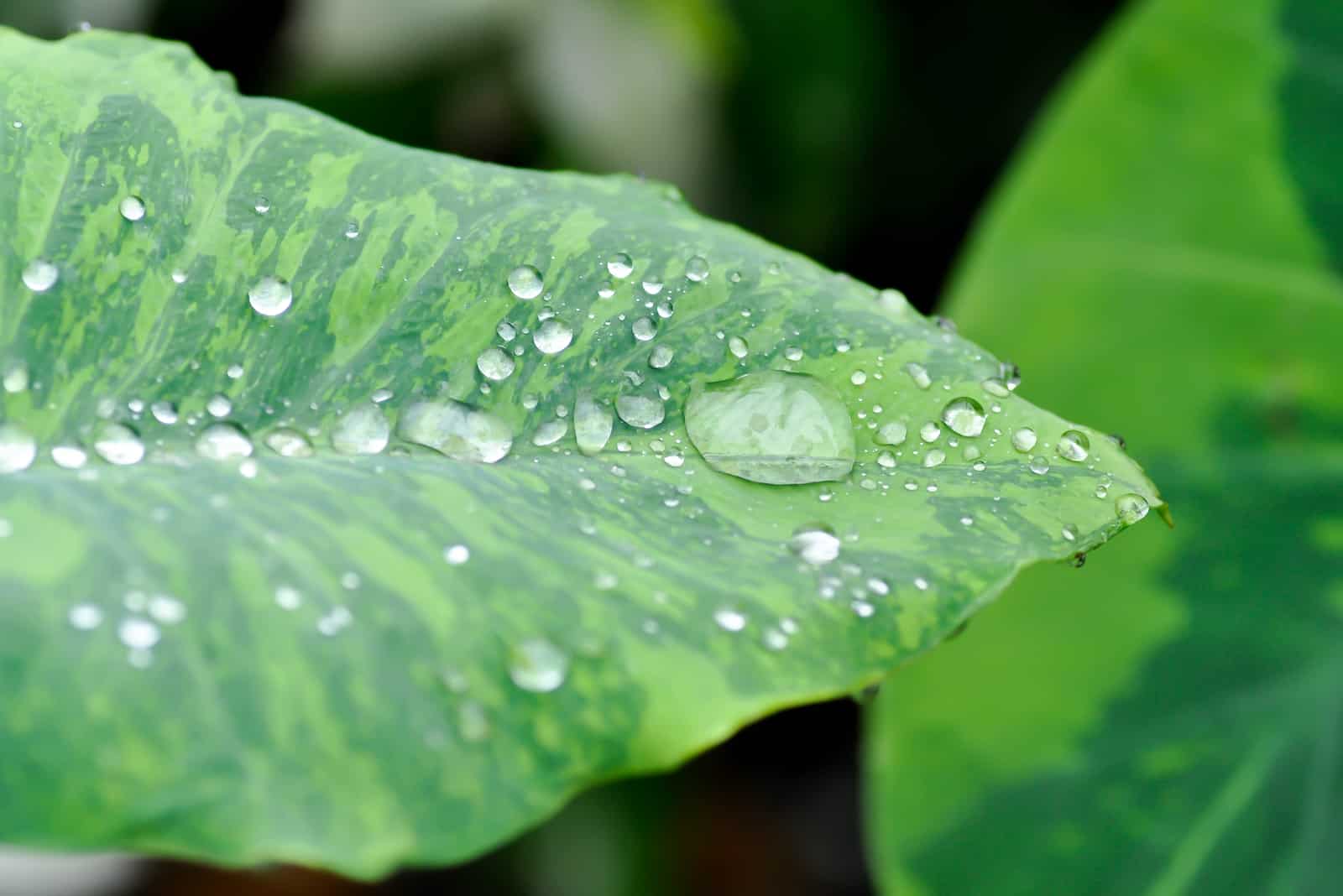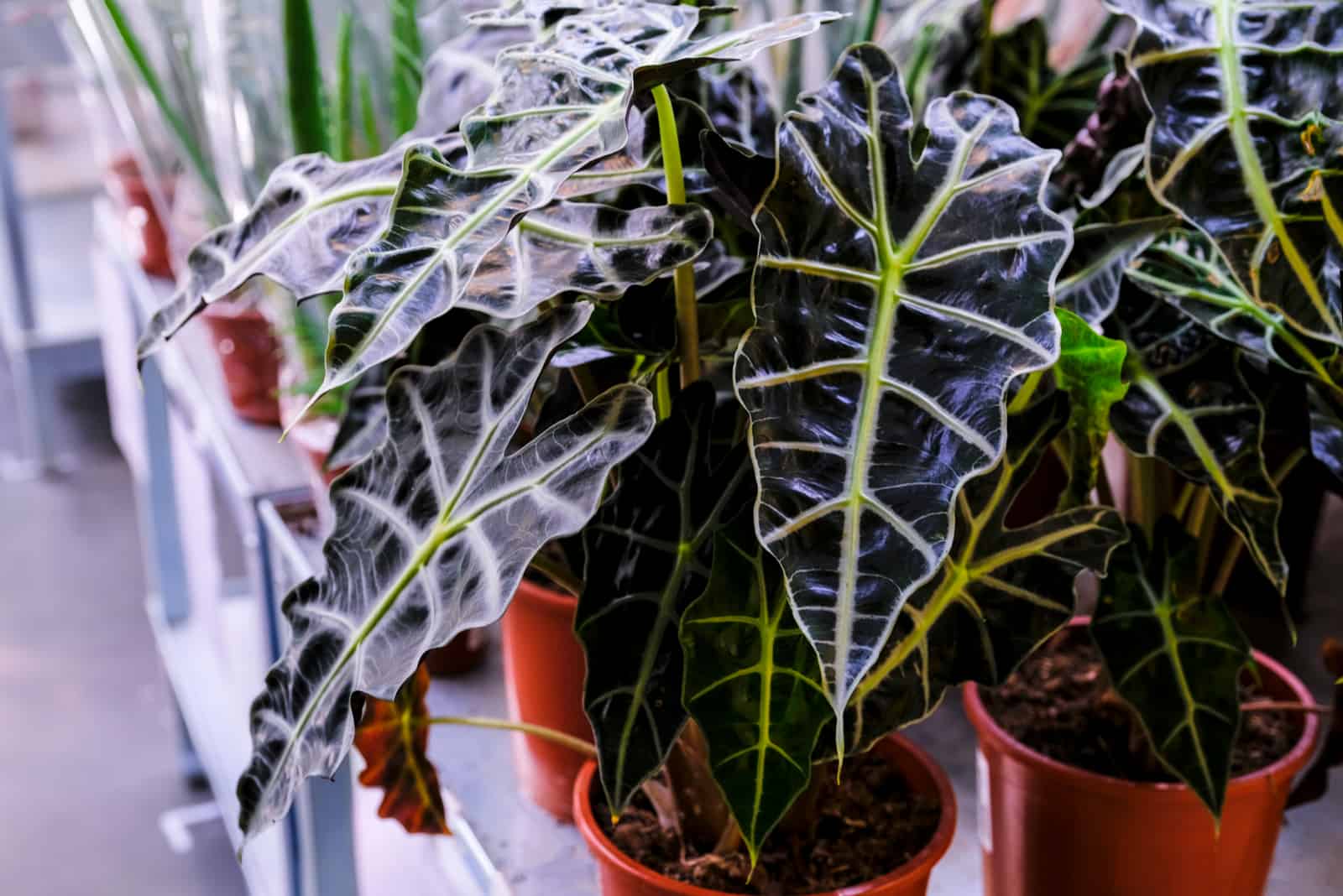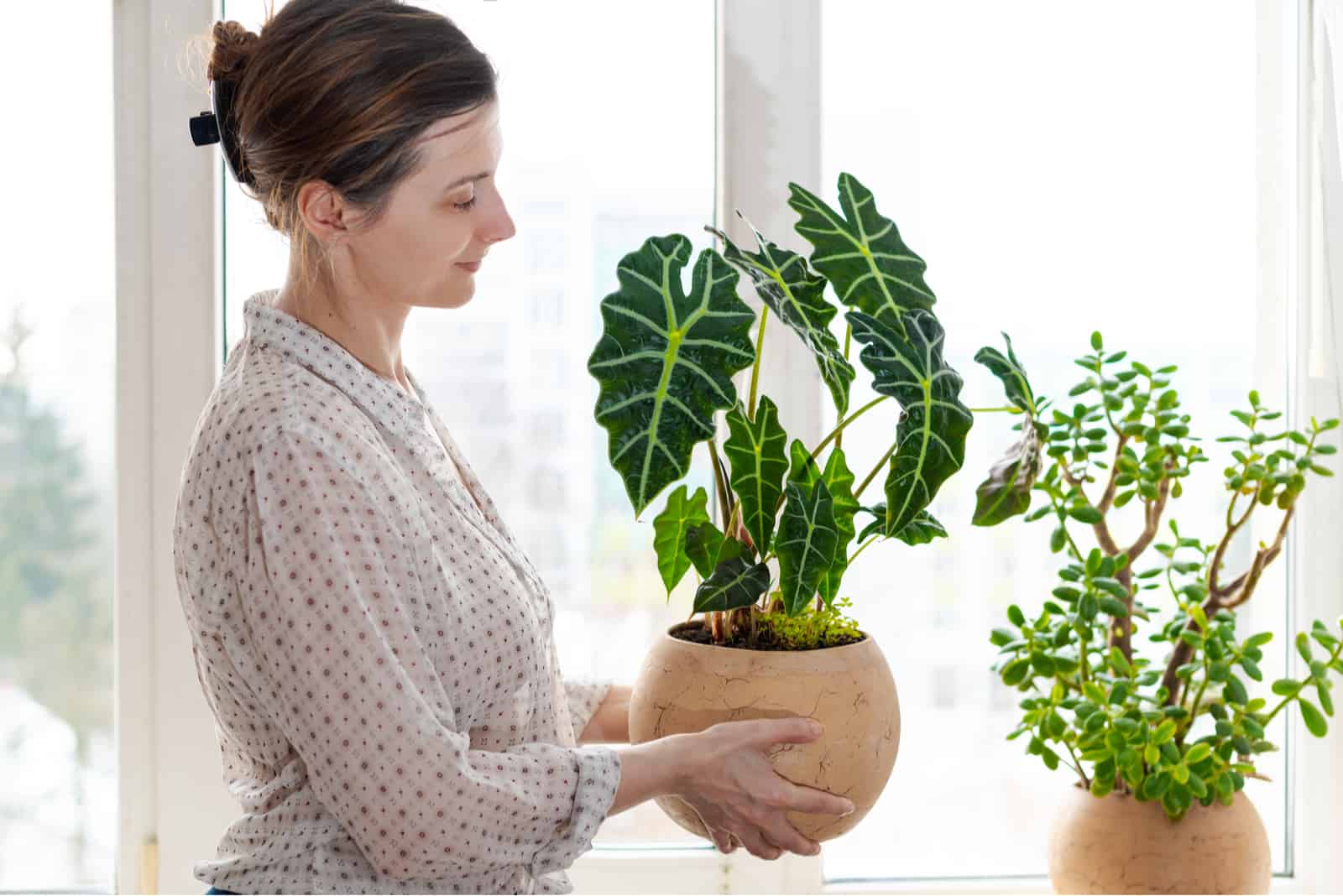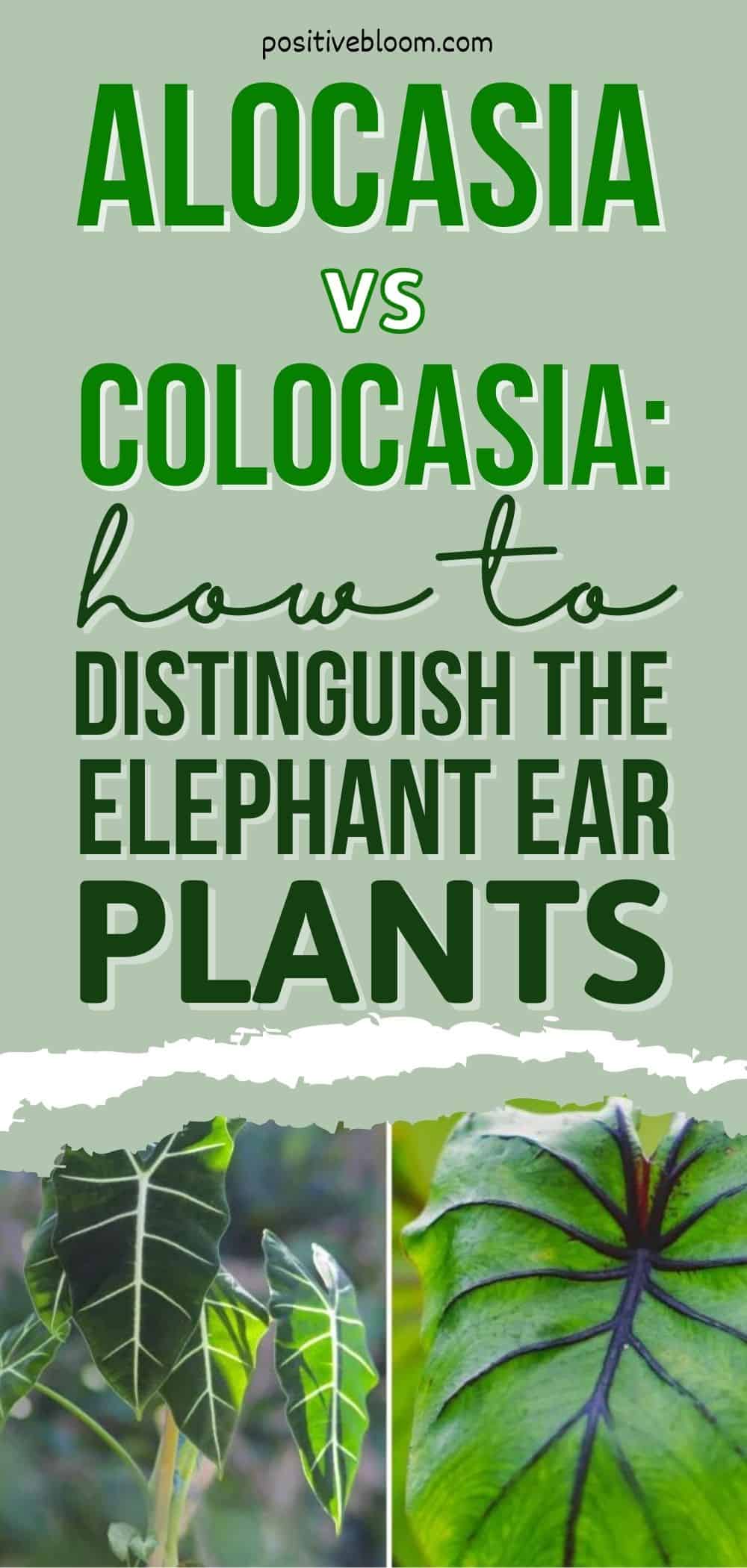Alocasia and Colocasia are popular houseplants in horticulture, mainly because they are pretty easy to take care of and they look so extravagant!
Not only do they share similar features, but they also share a nickname and are referred to as “elephant ears”.
When plant enthusiasts are talking about the elephant in the room, they might be referring to alocasia or colocasia!
If you are planning to buy a specific elephant ears plant, but aren’t quite sure how to distinguish one from another, check out our analysis of Alocasia vs Colocasia to find the answer!
Alocasia vs Colocasia: The Main Differences
Both Alocasia and Colocasia are members of the aroid family called Araceae, whose members are regularly cultivated as houseplants.
As they come from the same family, it can be quite hard to differentiate between them. The plants have limited features and often you have to look at the little details to be able to distinguish which species is which.
When it comes to Alocasia vs Colocasia, it’s important to analyze the leaves, growing requirements, and structure of the roots and flowers.
You will also find out which one of the Elephant ear plants is edible and which one isn’t.
Let’s dive in!
The Leaves
When we look at the leaves of some plants, we notice the shape and size first. We don’t even think about the direction of the leaves.
To be honest, before starting my own plant collection, I didn’t even know that leaf direction was a thing.
Well, when it comes to Alocasia vs Colocasia, the direction of leaves is what actually differentiates them.
Alocasia plants have a horizontal direction and the petioles are elongated into the leaves, which is why the leaf tips point upwards. The leaf shape is arrowhead, although sometimes they can be heart-shaped as well. Alocasia leaves appear green and glossy, with distinctive veins on the underside.
On the contrary, Colocasia plants have petioles that extend down from the notch into the leaves, which is why the leaves of Colocasia appear to be drooping downwards. They have a matte, dark green color without any prominent veins, and they differ in shape as well, as Colocasia leaves seem to have a more rounded shape compared to the Alocasia leaf shape.
Edibility
It’s rare to encounter an edible houseplant, as the majority of them are toxic and should be kept away from kids and pets.
When it comes to Elephant ear plants, you should know that only certain parts of the Colocasia can be eaten. For instance, Colocasia tubers, common name Taro, is an edible part of this plant sold as food crops in Hawaii, where these plants are extensively cultivated.
If you ever go on vacation to Hawaii, go into any grocery store and you will definitely find Taro for cheap!
The majority of Alocasia plants are not edible, although there are some types that have edible stems, but I would suggest you don’t eat them.
Use the large leaves for ornamental purposes, but don’t try to cook them! It would be such a shame to eat these beautiful, green leaves… maybe that’s why the majority of houseplants are toxic?
Roots & Flowers
We can barely see any differences between these plants, can you guess why?
It’s because they are hidden underground!
That’s right! Even though they look practically the same, the structure of their roots differ. While Colocasia produces only large tubers that can be used as a food crop, the Alocasia grows thinner tubers together with rhizomes.
When propagating, you should separate tubers from rhizomes in Alocasia. When it comes to Colocasia, only tubers are separated and used for propagation.
If we look at the female flowers, we can see that in Alocasia plants the placenta is basal and contains attached ovaries and stems alongside the interior base.
In Colocasia plants, the placenta is on the inner side, with stem and ovaries connected through the interior side of an ovary.
Growing requirements
When growing members of the same family, it is common for them to have the same growing requirements. However, that is not the case with Elephant ear plants.
Let’s take a look at the water requirements first.
For instance, Colocasia might be the only plant that loves having soggy soil. It can grow in constantly wet soil and even in standing water!
On the other hand, the Alocasia doesn’t prefer having moist soil for too long as it can lead to root rot, which affects the overall health of the plant. This means it would be best for you to plant your Alocasia in well-draining soil that doesn’t retain moisture.
When it comes to light requirements, Colocasia can be grown in full sun exposure, while Alocasia prefers slightly shaded areas.
Everything else is pretty much the same when it comes to the growing requirements and care guide. You can also check out this video for more information:
More About Elephant Ear Plants
Now that we know the differences, let’s look into some Alocasia vs Colocasia similarities and learn how and when to plant them. You will also find a step by step care guide for these plants in this section.
Both Alocasia and Colocasia are tropical plants famous for their beautiful, green leaves, which are used mainly for decorating purposes. It’s easy to imagine these beautiful large leaves in the corner of your room!
Everyone who sees them will want to talk about the elephant in the room; this plant simply cannot go unnoticed!
I personally love the jungle vibe in my room, and it is pretty easy to achieve that with Elephant ear plants because they capture the essence of the wilderness.
If they are grown in hardiness zones 9 to 11, they are winter-hardy and you can leave them outside for the whole year! They are treated as annuals, and if you live in a somewhat colder area it would be best to bring them indoors.
Why are they called “Elephant ear plants”?
The term “Elephant ear” kind of clumped them together in one group, mainly because of the leaf shape in both the Alocasia and Colocasia.
However, there is a special meaning behind the name Alocasia, which is “the tree that grows up to the heavens”. It is mentioned in a few fairytales, mostly for motivating young people to always take chances, even if they are risky.
Alocasia
Alocasia plants were originally found in Asia and eastern Australia, and the genus Alocasia has 97 species today.
Alocasia is a famous houseplant nowadays, and for good reason.
Primarily, the Alocasia is easy to take care of and can be grown indoors and outdoors, which is why it is one of the top choices in garden landscaping.
Those shiny leaves definitely steal the show!
Alocasia is mostly used as a decorative plant. It looks so extravagant and luxurious, which is why it is often a centerpiece in gardens and rooms.
It is a fast-growing plant, and that can sometimes cause problems because it may become invasive.
If you want to know more information about the Alocasia, check out the table below. Remember to always keep it away from kids and pets!
[table id=50 /]Colocasia
Colocasia plants originate from Asia, although today they can be found almost anywhere in the world!
They are perennial plants that grow beautiful, large leaves that come in different sizes and shapes as there are numerous Colocasia cultivars.
Primarily used for ornamental purposes, Colocasia plants bring jungly vibes into any room and garden. Some people who want a little jungle in their backyards often combine them with succulents, bananas and cacti, fern trees, or caladium.
An interesting thing about the Colocasia is that you can actually eat its tubers – that’s right, they are used as food crops, especially in Hawaii where you can buy them in grocery stores.
The key information about Colocasia is presented in the table below.
[table id=51 /]Types of Elephant Ear Plants
There are many elephant ear species and cultivars that are grown as houseplants, so you can pick and choose to find the right fit for your style.
They differ from one another when it comes to the color of the leaves. Other than that, they are practically the same. There are many hybrids as well, as cultivators are always breeding and combining different plants in order to achieve the coolest Elephant ear plant possible!
If you like plants with variegated leaves, then I would suggest buying Alocasia Odora Variegata, however quite popular nowadays are also Jewel Alocasia and Alocasia Purple Sword Plants.
Now, let’s take a look at different Alocasia and Colocasia species.
1. Alocasia cuprea “Red Secret”
The Alocasia cuprea has unique red and bronzy leaves, hence the name “Red secret”. Its height reaches about 3 feet tall and it is easy to take care of. I would recommend you buy an Alocasia cuprea if your style is a bit edgier, especially because of the metallic leaves!
2. Alocasia “Zebrina“
Alocasia Zebrina is one of the most famous hybrid cultivars because it has leaves shaped like arrowheads and stalks that have Zebra prints all over them – so chic, so modern! In addition to this, they are relatively small at the beginning, although they can grow significantly larger over time.
3. Colocasia “Mojito”
Although the name refers to a delicious cocktail, in this case we are talking about a certain toxic plant type. Do not try to eat the Mojito plant, it tastes nothing like it and you will definitely get sick (however, this can also happen if you have too many Mojitos!).
The Colocasia “Mojito” has variegated green leaves with random black freckles and patches all over them, which makes it the perfect plant for all the nyctophiles out there!
4. Colocasia Esculenta “Illustris”
This dramatic plant has matte green leaves with distinctive bright veins, and a rounded, ball-shaped corm. Instead of tubers, it uses runners to spread underground. If you live in a region with wet soil, then the Colocasia Esculenta is the right choice for you.
5. Alocasia reginula “Black Velvet”
Alocasia reginula, commonly known as Black Velvet, is a small houseplant that produces magnificent, lush dark green leaves with prominent white veins. Alocasia reginula actually means “little queen”, and based on its looks and compact growth habits, it truly deserves that title!
6. Colocasia gigantea “Thailand Giant”
This plant is called giant for good reason; its leaves can grow up to 6 feet long! It is a fast-growing plant with gigantic green leaves that are simply fascinating. It grows naturally in Thailand, hence the name Thailand Giant.
How To Plant Elephant Ear Plants
The easiest way to plant Alocasia or Colocasia is by actually buying corms and placing them in moist soil. Bear in mind that the Colocasia likes wet soil and can even be grown in standing water.
The Alocasia is a bit different when it comes to soil preference. It prefers slightly moist and well-draining soil.
Schedule planting according to the soil temperature. You should wait at least two weeks until the last frost has passed. I would recommend you plant in late spring so the soil has enough time to warm up.
You can actually start the plants indoors if you want to extend the growing season.
They absolutely love nutrient-rich soil, so before planting you should add organic matter to the spot where you planned to plant your corm.
If you decide to go with a pot, then put peat-free compost in relatively large pots as they need space for their roots to grow. The corms should be placed with the pointed side facing up. Sow the tubers a couple of centimeters below the soil surface, then place the pot somewhere sunny.
How To Care For Elephant Ear Plants
If you managed to plant the soil or you just bought a brand new one, check out the care guide for Elephant ear plants and to keep them happy and healthy!
Soil
They both absolutely love nutrient-rich soil, however if you have Alocasia, then you should provide it with well-draining soil. Mix soil with perlite and use it as a potting mix.
On the other hand, Colocasia loves being in wet and soggy soil, so it can tolerate a lot. You can mix perlite together with loam and peat moss in order to make the perfect potting soil.
Temperature
As tropical plants, both Alocasia and Colocasia thrive in warm temperatures ranging from 70 to 85 degrees Fahrenheit during daytime, and 60 degrees Fahrenheit minimum at night.
If the winter is coming, then you should take your plant indoors. Always store the tubers inside and plant them again next year.
Light requirements
Both of them can tolerate full sun, although they prefer partial shade. Too much direct sunlight would burn those magnificent leaves, and we don’t want that!
Plants with darker leaves prefer growing in shady areas, while Elephant ear plant varieties with light green leaves enjoy full sun exposure.
When growing indoors, place them near a window where they will get enough indirect and bright light, and your Elephant ear plant will be happy!
Water
Elephant ear plants require frequent watering, especially Colocasia!
During the growing season, you should water them 2-3 times a week, though Colocasia can be watered daily throughout the summer because they adore soggy soil.
When the winter comes, you should ease down the watering to 1 inch per week because they go dormant, and frequent watering would only cause root rot.
Fertilizer
It is well known that Elephant ear plants are heavy feeders, so they will need fertilizers now and then. You should use balanced liquid fertilizer and apply it every two weeks during the growing season, and your Elephant ear plant will grow big and strong!
Be careful not to over fertilize your beloved plant as it can lead to chemical build up in the soil, which will affect the overall health of the plant.
During winter, you can leave your plant to rest and not fertilize it at all.
Pruning
Trust me, I know it’s hard to cut off those magnificent, large leaves, but we want to keep our precious plant healthy and growing!
Timing is also important when pruning because there is a special overwintering procedure where all leaves are removed and you only save the corm for the next growing season.
So, how do you actually prune your Alocasia or Colocasia?
The right time to prune your Elephant ear plant would be after the first frost hits and the leaves turn brown. So, when you notice that the weather is colder and the majestic, green leaves have started turning brown, then you know that it’s time for pruning and saving the corm.
Sterilize your pruning shears and cut the leaves near the base, leaving about 2 inches above the ground. Cut off all the leaves, and your plant (well, what’s left of it) will be ready for the upcoming winter.
Propagation
Propagation is a bit different when it comes to Elephant ear plants. While the majority of plants are propagated by cutting stems, we use tubers or rhizomes when propagating Elephant ear plants.
First, dig out the parent plant and choose newly formed tubers with roots. Then separate it by cutting with disinfected shears. After doing this, put the baby tuber into a container filled with proper soil mixture.
Make sure that your pot has drainage holes at the bottom so the excess water can drain.
Place the new baby plant somewhere dark and cool until the spring comes, then plant it outside in a partially shaded area.
Common Problems With Elephant Ear Plants
Now that we have finished the care guide, you may be wondering what issues you might encounter while growing the statement-making Elephant Ear plant.
Even though it’s known for being hardy, this plant is unfortunately susceptible to some pests and diseases.
Let’s look at some common problems with Elephant ear plants!
Invasive
If you are planning to grow an Elephant ear plant in your garden, you should know that it is going to try and take over all the space regardless of the plants nearby.
Not only does it cause problems with its huge leaves, which block sunlight for the rest of the plants in your garden, but its roots are always on a mission to go as far as they can to produce new corms elsewhere.
It is pretty common to spot a new Elephant ear plant far away from the original plant, especially if you are not doing anything to prevent new growth.
Leaves Changing Color
The leaves reflect the overall health of the plant. If you notice any changes in color, size, and shape, it usually means there is something wrong with your plant.
If the leaves are starting to look yellow, it can be a sign of overwatering. On the contrary, if the tips of the leaves turn brown, it’s usually an indicator of underwatering.
Don’t worry, you can still save your plant, just make sure to provide it with enough water and everything will be fine!
Other problems might occur if your plant isn’t getting enough nutrients. This can cause stunted leaf growth, so your magnificent plant won’t be able to produce leaves as big as it normally would!
Pests & Diseases
Unfortunately, your plant is prone to pests such as spider mites. If you notice any spots on the leaves and stems, it might be a pest infestation.
To prevent these annoying spider mites from invading your plant, make sure to keep it dry over winter. You can also go to a gardening center and buy pesticides. However, I would suggest you go organic and spray neem oil on the leaves instead.
Fungal leaf blight is a disease found in many Elephant ear plants, and it is caused by a fungus called Phytophthora colocasiae. This annoying little fungi produces round lesions on those precious leaves, changing the color to yellow and purple. It kills the leaf first, then spreads to the corm and ruins the whole plant.
Fungal leaf blight can be treated with fungicides that contain copper, just make sure to spray it once a week on the spotted areas and hope for the best!
Frequently Asked Questions
What is the difference between an Elephant ear and Alocasia?
There is no difference between an Elephant ear and Alocasia, they are basically the same plant. Alocasia is called the Elephant ear plant because the size and shape of the leaves remind us of Elephant ears!
How to differentiate between Alocasia and Colocasia
The majority of Elephant ear plants look similar, and it can be tricky to distinguish one from another. You really have to investigate them in great detail!
First, look at the leaves; Alocasia has shiny leaves that point upwards, while Colocasia has somewhat matte leaves that are drooping downwards. Also, Alocasia leaves have much more prominent veins than Colocasia.
If you take a look at what is happening underground, you will see that Colocasia grows only tubers, while Alocasia grows both tubers and rhizomes, which are used for propagation.
Are Taro and Colocasia the same?
When we say Taro, we are referring to an edible Colocasia species that produces tubers which are used as food crops. You can buy them in local grocery stores in tropical regions, especially in Hawaii.
Conclusion
Now that we have analyzed alocasia vs colocasia in great detail, I hope we made it easier for you to decide which plant to buy.
However, you can’t go wrong with either of them!
They are both majestic, statement-making plants that will bring the jungle spirit to your garden or make your room look more lively.
Yes, you can plant both outdoors and indoors, just make sure to bring them inside before the winter so your plants will be prepped for the next growing season.
They are easy to take care of; just place them in an area with partial shade and water them regularly. Bear in mind that the Colocasia prefers soggy soil, so you will have to water it a bit more frequently than the Alocasia.
Use fertilizers only during the growing season, keep them pest-free, and your plant will live happy and healthy for a long time!
Until next time!
Like this post? Share or pin it for later!

